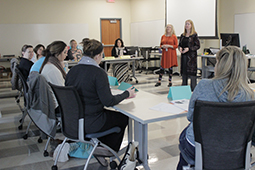Counseling and Higher Education works with Teacher Education in a new study about students impacted by trauma and how teachers can help

Photographer: Kim BarlagPerianne Bates (L) and Tamarine Foreman (R) hold a workshop to train teachers to implement strategies to create a trauma-informed classroom.
In recent years, there has been a growing concern regarding the prevalence of traumatic experiences among students and how these experiences affect learning and behavior in the classroom. A new study by Patton College of Education faculty is helping teachers recognize the signs of trauma and facilitate learning and growth.
Dr. Tamarine Foreman, Counseling and Higher Education assistant professor, and Perianne Bates, Teacher Education senior lecturer, are principal investigator and key personnel respectively on this study, “Supporting Students Impacted by Trauma; Recognizing & Helping Students Recover from Adverse Childhood Experiences (ACEs).” It is funded by a $50,000 grant that the Southeast Ohio Teacher Development Collaborative (SEOTDC) received from the Ohio Department of Higher Education (ODHE).
“The purpose of this study is to train teachers to implement strategies to create a trauma-informed classroom,” said Foreman, who will serve as project director and principal investigator. “Through the lens of a trauma-informed classroom, teachers will have a greater ability to educate all students, promote healing and resilience among students, and help students perform better academically, attend school in a more consistent manner, and decrease referrals for discipline.”
Traumatic experiences range from a single event to events or circumstances experienced regularly or in recurring fashion over a period of time. Trauma may include, for example, physical or sexual abuse, witnessing domestic violence, removal from a parent’s home, or the death of a loved one. These experiences can impact an individual’s interpersonal, intrapersonal, emotional, physical, and spiritual well-being.
That impact, of course, does not end when a student walks into a classroom.
“Therapeutic classrooms are necessary for the academic and social-emotional development of children who have experienced trauma,” said Bates, an intervention specialist. “Studies have shown that executive functioning is underdeveloped in many learners who have been exposed to trauma. This affects learner organization, memory, concentration, and self-regulation, among other things. These types of deficits have significant effects on a learner's performance in the educational setting.”
School employees, meanwhile, are in prime position to observe these deficits and see how trauma impacts a student’s emotional and social behavior. They just need to know what to look for – and how to respond.
“Our goal is to research and develop best practices to assist teachers in supporting students impacted by trauma and help teachers facilitate student progress and growth,” said Foreman. “We want to foster resilience in students who have been exposed to trauma or endured an adverse childhood experience.”
Collaboration among SEOTDC partners will be key. SEOTDC is a partnership among five teacher-preparation programs in Southeast Ohio: Marietta College, Muskingum University, Ohio University, Shawnee State University, and University of Rio Grande. It seeks to improve teacher preparation through partnerships with local schools, supporting and developing best practices to help ensure the success of all students.
Foreman and Bates are working with 11 teachers from five schools in Southeast Ohio from July 2018 to July 2019 to examine attitudes toward – and understanding of – implementing a trauma-informed classroom. Each of these schools work with one of the SEOTDC partners through placement of their teacher candidates. They will collect and analyze quantitative and qualitative data using pre- and post-project surveys, classroom observations, teacher interviews, and aggregate student data.
The study will seek to answer three basic questions: How do teachers describe the impact of trauma on their students, their classroom, and on themselves? How do teachers describe their approach to developing and maintaining a trauma-informed classroom before and after training, as well as in the middle and end of the school year? And what changes are observed in students’ attendance, discipline referrals, and academic progress in the participating teachers’ classrooms?
Foreman and Bates believe a trauma-informed classroom could improve student performance, attendance, and behaviors, as well as teachers’ ability to recognize trauma and the ways in which it impacts student development and learning. They also hope to show teachers how to respond to students through a trauma-informed lens and explain how to avoid re-traumatizing the student.
Bates, who spent nine years teaching learners with emotional and/or behavioral disorders, knows firsthand how imperative this work it.
“I found that the majority, if not all, of my identified students had experienced, or were currently experiencing, traumatic events in their lives,” she said. “This knowledge has driven my passion for creating a therapeutic classroom for all learners, as we do not always know if a child has experienced trauma. Given this, the concept of a classroom with built-in therapeutic supports needs to be universally designed and implemented so that all children may thrive academically, socially, and emotionally in the educational setting.”
Bates and Foreman’s research findings will be shared with participating schools and presented at local, state, regional, and national conferences for both educators and counselors. Potential conferences for dissemination include: American Education Research Association, All Ohio Counselor Conference, and The Ohio Confederation of Teacher Education Conference. Research will also be disseminated through the publication of manuscripts in peer-reviewed journals.
“There is an opportunity to further this line of inquiry, expand the work within school systems, and develop trauma training to enhance teacher and administrator leadership,” said Foreman. “The initial findings from this project can support broader research proposals that support research-to-practice partnerships. Ultimately, we hope to create and maintain as many trauma-informed classrooms as possible.”

Photo courtesy of: University Communications and MarketingDr. Tamarine Foreman, Counseling and Higher Education assistant professor is the principal investigator on this study.

Photographer: Kim BarlagPerianne Bates, Teacher Education senior lecturer, is key personnel on this study.
